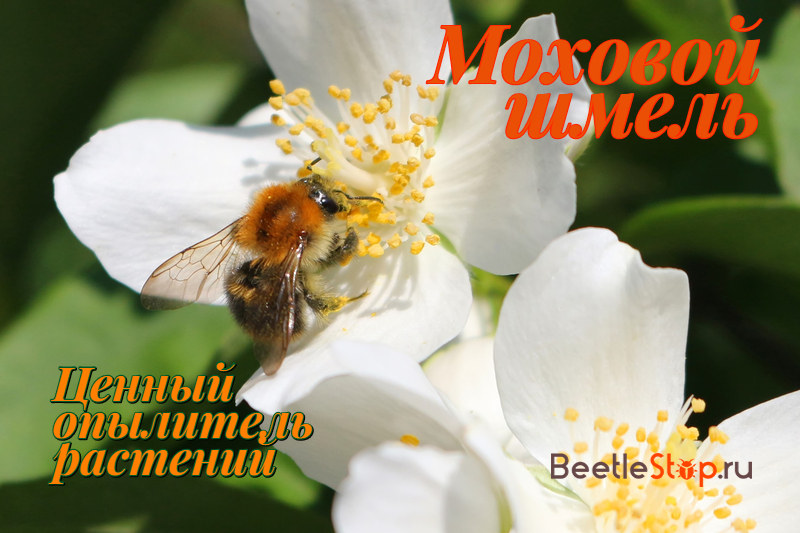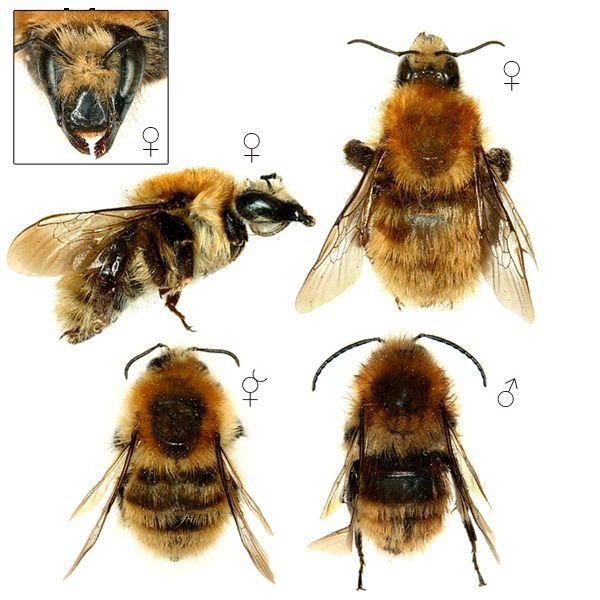Moss Bumblebee - a fluffy pollinator of gardens and fields
Bumblebees belong to the family of real bees. Insects are valuable pollinators of plants. Their ability to heat up allows you to start collecting nectar before bees. Moss bumblebee is covered with long thick hairs, which allows you to adapt to difficult climatic conditions. Insects are calm and hardworking. The species lives in places with intensive agricultural activity. Processing plants with insecticides leads to the destruction of beneficial Hymenoptera. Moss bumblebee is listed in the Red Book of many regions of Russia.

Morphological description of the species
Bumblebee moss (Bombusmuscorus) belongs to the order Hymenoptera, a family of real bees, a genus of bumblebees. Insects of medium size, dimensions of an individual depend on its hierarchy in the family. The body length of the uterus is 17-18 mm, the workers are 10-15 mm, the males are 14-15 mm. A characteristic feature of the species is the uniform color of the back and abdomen. The back is covered with reddish or yellow hairs, the abdomen is yellow, but stripes corresponding to tergites are noticeable.
The head of the females is elongated, with a wide nape. Lateral parts of clypeus in rare yellow hairs. Thick hairs of the same color on the forehead. In addition to well-developed complex facet eyes, it has 3 simple eyes. Their upper part is located in line with the apex of the main organs of vision. Antennae 12-segmented. The upper chest is yellow-brown or brownish. On the sides and bottom, the color is lighter.
As can be seen in the photo, the limbs of the moss bumblebee females have a special apparatus for collecting pollen. Spurs and long hairs on the hind tibia form a “basket”.

Males have a triangular head; antennae consist of 13 segments. The back of the bumblebee is yellow, with a slight admixture of dark hairs. Abdomen consists of 7 tergites. The male does not have a sting, but there is a claw-shaped copulative organ.
Distribution area
Moss bumblebee belongs to the Palearctic species. Insects are common in Europe, Asia Minor, Kazakhstan, Mongolia, China, Turkey. It is found in Russia in Siberia, the Urals, the Far East, the Caucasus, and the Crimea.
Lifestyle
Moss bumblebees are the main pollinators of plants in the habitat. They sit on all the flowers, but give preference to families:
- legumes - clover, alfalfa;
- compound flowers - thistle, marigolds, daisies;
- labioids - lemon balm, mint.

Gardeners and gardeners welcome the advent of bumblebees. Insects cope well with pollination of beds and greenhouses. The species Bombusmuscorus is resistant to low temperatures. Adults are able to independently generate heat by muscle contraction. This feature allows you to be the first to go for pollen in the morning hours, without waiting for an increase in air temperature.
Social insects live in families with one uterus capable of breeding. One group consists of 50-100 individuals. Habitats - meadows, forest edge, fields with clover crops, wide bright glades, orchards. Locations are small. The life expectancy of the uterus is 1 year, workers and males - 1-3 months.
Bumblebee bite
The uterus and working females have a sting. Insects rarely show aggression towards humans.They attack when defending a nest or in case of harm. The bumblebee sting is smooth, so the female inflicts several attacks on the enemy. A small amount of poison is injected. Concentration is not harmful to human health. In case of an allergy to poison, you must go to the hospital.
Reproduction and development
Fertilized females wake up in the spring, in April. They feed on flower nectar and tree sap. Having replenished their strength, they begin to search for a place for the nest. The uterus builds oval cells from wax in dry grass on the surface of sandy soil or among hummocks. The founder of the family prepares a nutrient substrate from honey and pollen, lays eggs in it. The time of appearance of the larvae depends on temperature, usually the egg phase takes 2-5 days.
Interesting fact. Bumblebees regulate the temperature in the nest; to increase it, they warm the body by tension of the pectoral muscles. Cooling occurs due to the flow of air from flapping wings.
Ready stocks last for a short time, the uterus has to fly for new portions of pollen for brood. The larva molts 3 times and passes 4 ages. After 7-14 days, she weaves a cocoon and turns into a chrysalis. The phase takes 5-12 days, then the imago appears. Workers take on flights for food, mending cocoons, and brood care. The uterus is only engaged in the reproduction of new eggs.

At the end of summer, males appear from unfertilized eggs, and females with reproductive function appear from fertilized eggs. Young females actively fly to flowers, accumulating reserves for a long winter. After mating, insects fly out of the nest and die. Fertilized females hide under moss, in abandoned rodent nests, under heaps of leaves. In a state of suspended animation, they will spend the autumn and winter months to give life to new families in the spring.

Interesting fact. Males cannot tolerate nectar, on their limbs there are no devices that form the collective apparatus.
Limiting factors
The reduction in the number of natural pollinators is facilitated by human activities:
- reduction in the area of sites suitable for the construction of nests;
- development of valley meadows where nectar was collected;
- death of adults by spraying fields with insecticides;
- adverse climatic factors - drought and high humidity;
- trampling nests by cattle on pastures;
- wintering females die when burning leaves and grass.
Security measures
Species Bombusmuscorus is listed in the Red Book of the Saratov Region, Krasnodar Territory as “specially controlled”, in the Tomsk Region it is classified as “small vulnerable species”. In the habitats of moss bumblebees, the creation of micro-reserves is recommended. In wastelands of settlements fodder plants are sowed. Protect nests from destruction, limit the use of pesticides.

